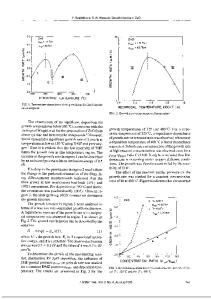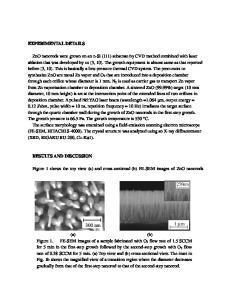Effects of Laser Ablation on Growth of ZnO/ZnS/ZnO Multilayer Structured Nanorods by Chemical Vapor Deposition
- PDF / 326,085 Bytes
- 6 Pages / 612 x 792 pts (letter) Page_size
- 77 Downloads / 374 Views
1144-LL13-13
Effects of Laser Ablation on Growth of ZnO/ZnS/ZnO Multilayer Structured Nanorods by Chemical Vapor Deposition Takashi Hirate, Hiroaki Koisikawa, Makoto Yugi, Takuya Kumada, Yuki Matsuzawa and Tomomasa Satoh Department of Electronics and Informatics Frontiers Faculty of Engineering, Kanagawa University 3-27 Rokkakubashi, Kanagawa-ku, Yokohama, 221-8686, Japan
ABSTRACT We study effects of laser ablation of Mn on growth of ZnS:Mn layer on ZnO nanorods grown by chemical vapor deposition cooperated with laser ablation of Mn and on growth of ZnO(Mn) layer on the ZnS:Mn layer. It is concluded that the laser ablation of Mn performed during growth of ZnS:Mn layer and ZnO(Mn) layer promotes the growth of each layer. And we fabricated ZnO nanorods double-coated with ZnS:Mn layer and ZnO(Mn) layer.
INTRODUCTION Zinc oxide (ZnO), a wide-direct-bandgap (3.37 eV) semiconductor, is an attractive II-VI compound semiconductor material for various optoelectronic devices. Recently, growth of various nanostructures of ZnO such as nanorod, nanobelt, nanowall, etc. has been reported [1-11], and ZnO has been considered as a promising material for nanodevices. We have studied on application of ZnO nanorods to electroluminescent devices. In this paper we report on fabrication of ZnO nanorods double-coated with ZnS:Mn layer and ZnO(Mn) layer to apply ZnO nanorods to DC-operated electroluminescent devices, cooperating laser ablation of Mn during growth of ZnS and ZnO by chemical vapor deposition (CVD).
EXPERIMENTAL DETAILS ZnO nanorods coated with ZnS:Mn and ZnO(Mn) layers are sequentially grown on an n-Si (111) substrate by CVD method cooperated with laser ablation that is developed by us. The growth equipment is similar that reported before [1, 8]. This is basically a low-pressure thermal CVD system. The precursors are metal Zn vapor and O2 or H2S to synthesize ZnO or H2S respectively. Zn vapor is introduced into a deposition chamber through orifice whose diameter is 1 mm. N2 is used as carrier gas to transport Zn vapor from Zn vaporization chamber to
Table 1. Growth conditions for ZnO:Mn/ZnS:Mn/ZnO nanorods growth. 1st. ZnO Zn Evaporation Temperature [C] Flow Rate of N2 for Zn [SCCM] Flow Rate of O2 or H2S [SCCM] Growth Temperature [C] Growth Pressure [Pa] Growth Time [Min] Laser Power [W]
0.8 (O2 ) 500 15 0.6
2nd. ZnS:Mn 585 7 1.0 (H2 S) 400 13 25 0.8
3rd. ZnO:Mn
0.8 (O2 ) 500 15 0.6
deposition chamber. O2 or H2S is also introduced into deposition chamber. A Mn (99.99%) target (10 mm diameter, 10 mm height) is set in deposition chamber. A pulsed Nd:YAG laser beam (wavelength =1.064 µm, pulse width = 10 ns, repetition frequency = 10 Hz) irradiates the Mn target surface through the quartz window. The growth conditions are listed in Table 1. Firstly, ZnO nanorods are grown on an n-Si (111) substrate with laser ablation of Mn in initial 3 min of growth. Then, after changing of growth temperature to 400 C in 5 min, ZnS:Mn layer is grown. The laser ablation of Mn is performed during the growth. Thirdly, after returning o
Data Loading...











